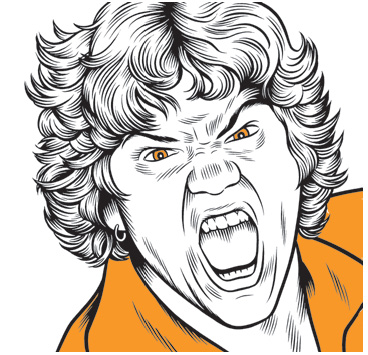In 1999, Larry Sweeney was still Alex Whybrow, a freshman at Oberlin College. He was a sweet-faced hippie kid in baggy cargo pants who weighed about 140 pounds and played classical guitar. After graduation, Whybrow moved to Allentown, Pennsylvania to begin training at Chikara Wrestle Factory—a career move equivalent to a rock musician heading to Brooklyn.
The product of this postgrad study was “Sweet ‘n’ Sour” Larry Sweeney, a blustery, unhinged manager character who quickly became a unique fan favorite in the scrappy yet immensely popular independent wrestling promotion Ring of Honor. Nowadays, he barges into rings, not as an interfering schemer but as a fun-loving heel combatant given to tie-dye, fluffy blond perms, and statue-bronze skin—a swaggering cartoon of a Californian with brutally mercurial mood swings. From challenging a tiny, prepubescent audience member to an arm-wrestling match—and cheating—to interrupting a heated bout to instigate a sound-tracked strutting contest with his rival, Sweeney commands crowds, a skill that has served him well on his journey through the ranks of WWE hopefuls.
Sweeney has appeared on the legendary live television program Monday Night Raw, and carved out memorable story lines on a number of independent domestic and international circuits in Europe, Japan, and Mexico. He has thousands of MySpace followers and his own action figure. Still, to make ends meet, Whybrow supplements his wrestling earnings by working, at various points in time, as a housepainter, a Domino’s Pizza deliveryman, and a Kaplan tutor. When possible, he holds down an apartment of his own, but frequently crashes on the floors of friends and stays at residence hotels. What follows is a conflated, condensed, and edited transcript of two phone conversations I had with Whybrow, one in late May 2009, the other several weeks later, in mid-June.
—Andrew Simmons
I. “KRISHNA WAS A WRESTLER”
THE BELIEVER: What spawned Larry Sweeney?
ALEX WHYBROW: Larry is certain aspects of me with a big magnifying glass shined on them. All good wrestling characters are like that: amplifications of the wrestler’s personality. Larry’s egotistical, cocky, cowardly, and self-absorbed. He sort of embodies all sins. Initially, that was so I, Alex, could feel purer of spirit. I’ve been wrestling as this character for six years. I’m Larry when the cameras are rolling. It’s good to stick with him, as opposed to theater, where you’re constantly developing new roles for new performances.
BLVR: Have you learned anything from living as him so often?
AW: Larry has some positive attributes. He has great confidence in himself. He speaks well, and people pay attention to him.
BLVR: Do people call you Alex or Larry?
AW: The fans know me as Larry, and other wrestlers know me as Alex. I’m...
You have reached your article limit
Sign up for a digital subscription and continue reading all new issues, plus our entire archives, for just $1.50/month.
Already a subscriber? Sign in





